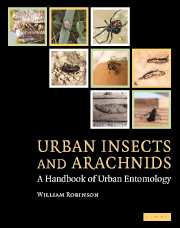Book contents
- Frontmatter
- Contents
- Preface
- Part I Urban entomology
- Part II Insects in the urban environment
- 4 Blattaria
- 5 Coleoptera
- 6 Collembola, Dermaptera
- 7 Diptera, Ephemeroptera
- 8 Hemiptera, Homoptera
- 9 Hymenoptera
- 10 Isoptera
- 11 Lepidoptera
- 12 Mantodea, Neuroptera
- 13 Orthoptera, Phasmatodea
- 14 Phthiraptera
- 15 Plecoptera, Psocoptera
- 16 Siphonaptera
- 17 Thysanoptera, Thysanura, Trichoptera
- Part III Other arthropods in the urban environment
- Family, genus, species index
- Index
- References
8 - Hemiptera, Homoptera
Published online by Cambridge University Press: 06 August 2009
- Frontmatter
- Contents
- Preface
- Part I Urban entomology
- Part II Insects in the urban environment
- 4 Blattaria
- 5 Coleoptera
- 6 Collembola, Dermaptera
- 7 Diptera, Ephemeroptera
- 8 Hemiptera, Homoptera
- 9 Hymenoptera
- 10 Isoptera
- 11 Lepidoptera
- 12 Mantodea, Neuroptera
- 13 Orthoptera, Phasmatodea
- 14 Phthiraptera
- 15 Plecoptera, Psocoptera
- 16 Siphonaptera
- 17 Thysanoptera, Thysanura, Trichoptera
- Part III Other arthropods in the urban environment
- Family, genus, species index
- Index
- References
Summary
HEMIPTERA
Introduction
Insects in the orders Hemiptera and Homoptera differ principally in the structure of the wings, and in the location of the mouthparts on the head. The front wings of Homoptera have a uniform texture, either leathery or membranous, and the mouthparts arise at the posterior of the head. The front wings of Hemiptera are divided into a thickened basal portion and a membranous apical portion, and the mouthparts arise from the front of the head. Some classifications include these insects in one order, Hemiptera, with two suborders: Heteroptera (previously Hemiptera) and Homoptera. Here the orders are considered separate.
Hemiptera may be wingless, brachypterous, or a combination of long-winged and brachcypterous forms in one species. These bugs have a piercing and suctorial proboscis that is attached anteriorly and flexed posteriorly when not in use. The primary food for the terrestrial species is plant fluids; some utilize insect or animal blood. Most aquatic species are predators on insects and other small animals. Several species are important plant and animal disease vectors, and are economically and medically important, especially in the tropics. Eggs are usually laid on or inserted in plants, or they are placed in crevices or they are attached to features of the substrate, which are near potential food for the immature stages. There are usually five nymph stages. Overwintering often occurs in the adult stage.
Pest status of this group is based on various behavior patterns.
- Type
- Chapter
- Information
- Urban Insects and ArachnidsA Handbook of Urban Entomology, pp. 202 - 223Publisher: Cambridge University PressPrint publication year: 2005

